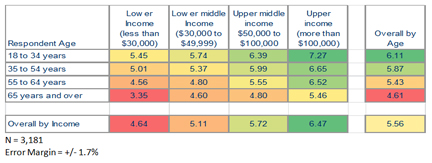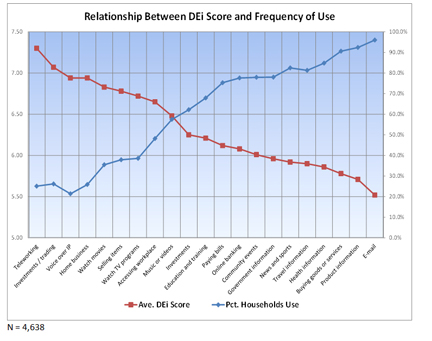by Derek Murphy & Michael Curri
The digital divide has long been commonly understood to mean unequal access to the Internet and its accompanying resources and services.
But as connectivity expands to more households, attention shifts to how people use and benefit from the Internet. Not surprisingly, another dimension to the digital divide emerges as not everyone is equally able to use and benefit from the Internet, even when they have and use the Internet. The same factors that impact adoption of the Internet have a pronounced impact on how effectively people are leveraging the Internet.
At SNG, utilization is a key metric we examine in all regions. In the past year, SNG collected utilization data in four states from over 12,534 organizations (commercial and non-commercial) and 4,638 households giving us unique insights into this new dimension to the digital divide. Some findings are not surprising while some provide new and unique insights that cause us to take a step back and wonder how we – as an industry – should define the digital divide moving forward.
The Big Picture:
Not surprisingly, SNG’s research shows that age and income have very significant impacts on how people use the Internet. Our proprietary Digital Economy index (DEi) summarizes how households use thirty distinct Internet activities. The higher the DEi, the more Internet activities a household engages. The Digital Economy index progression from 1 to 10 (10 being highest) reflects the number of e-solutions being utilized – 10 being a household at 100% utilization.
Utilization is impacted by income and age – the lower a household income or the older the household, the lower its Internet utilization. The differences (or divide) is most pronounced for those over 55 and those making less than $30,000. So the digital divide is actually expanding as younger, higher income households best leverage e-solutions.
 Click on chart for a larger version.
Click on chart for a larger version.
Without a ‘Next Step,’ It’s Just Numbers
SNG’s research (above) clearly shows:
- As we all know, computer and Internet skill levels affect broadband utilization, but more interestingly:
- The lower your income, the lower your utilization.
- The older you are, the lower your utilization.
So lower income individuals ages 55-plus land at the lowest level of utilization. Conversely, younger and upper income households are at a higher level of utilization, leveraging broadband more effectively and deriving the most benefits – further increasing the digital divide.
Simply connecting… or even basic adoption does not complete the process of bringing people and households into the digital world. Even among those who are already using the Internet, there is a digital divide.
So we need to do better, including designing Internet outreach and training programs to the groups that are still experiencing the divide. How will the older generation be able to use Telehealth if they can barely accomplish basic Internet activities?
Digging deeper, for those interested in the details!
Where, specifically, are household struggling to adopt Internet activities? Our studies show that some skills and activities are easier to learn than others – the table below shows the activities where there is still a divide. E-mail, browsing and research are actively used by 80% or more of households. However, teleworking, selling online and using VOIP are significantly more challenging – but that’s where the biggest benefits from utilization are derived.
 Click on chart for a larger version.
Click on chart for a larger version.
The earning ability of lower and middle income households is enhanced by the very Internet activities for which they’re least skilled. Economic development investments by government or nonprofits should focus on helping drive the utilization of e-solutions that generate the most benefits for individuals. A starting point might be more focused, targeted training for those e-solutions that have the most significant, long-lasting socio-economic impacts.
